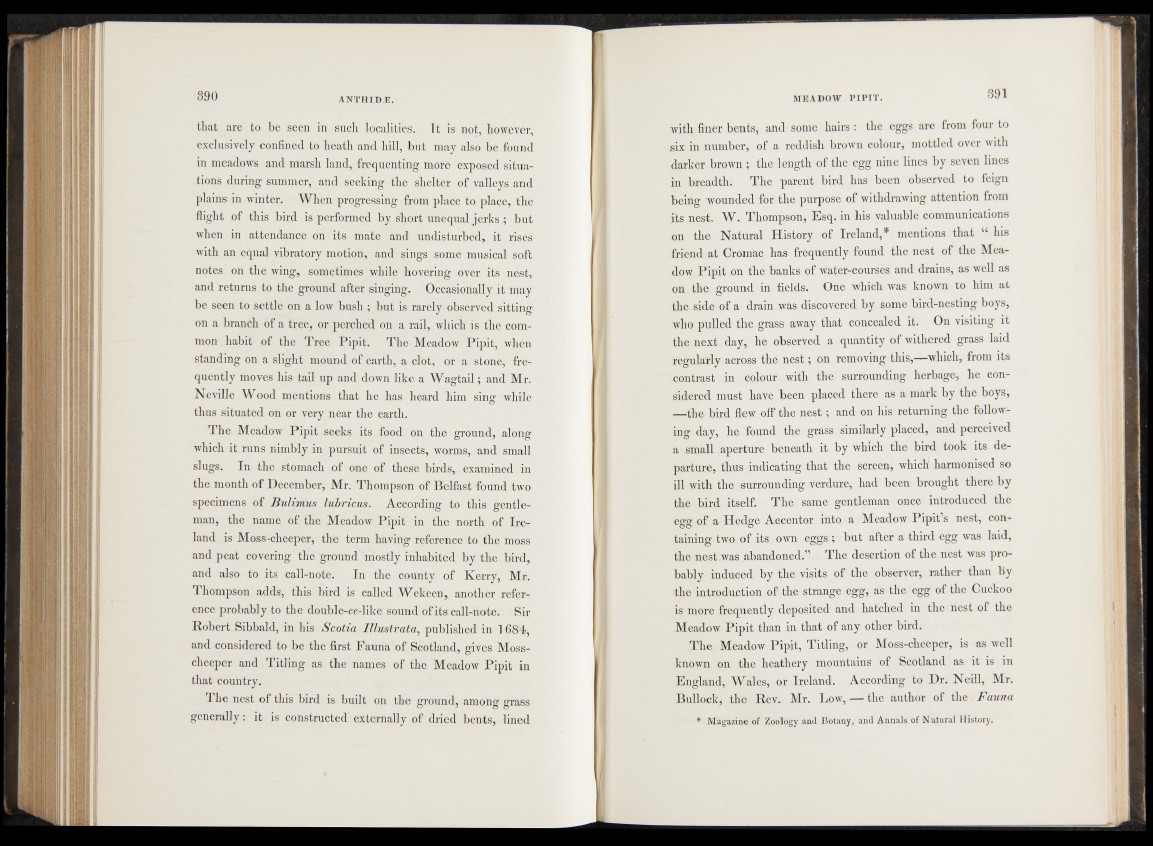
390 ANTH1D.E.
that are to be seen in such localities. Tt is not, however,
exclusively confined to heath and hill, but may also be found
in meadows and marsh land, frequenting more exposed situations
during summer, and seeking the shelter of valleys and
plains in winter. When progressing from place to place, the
flight of this bird is performed by short unequal jerks ; but
when in attendance on its mate and undisturbed, it rises
with an equal vibratory motion, and sings some musical soft
notes on the wing, sometimes while hovering over its nest,
and returns to the ground after singing. Occasionally it may
be seen to settle on a low bush ; but is rarely observed sitting
on a branch of a tree, or perched on a rail, which is the common
habit of the Tree Pipit. The Meadow Pipit, when
standing on a slight mound of earth, a clot, or a stone, frequently
moves his tail up and down like a Wagtail; and Mr.
Neville Wood mentions that he has heard him sing while
thus situated on or very near the earth.
The Meadow Pipit seeks its food on the ground, along
which it runs nimbly in pursuit of insects, worms, and small
slugs. In the stomach of one of these birds, examined in
the month of December, Mr. Thompson of Belfast found two
specimens of Bulimus lubricus. According to this gentleman,
the name of the Meadow Pipit in the north of Ireland
is Moss-cheeper, the term having reference to the moss
and peat covering the ground mostly inhabited by the bird,
and also to its call-note. In the county of Kerry, Mr.
Thompson adds, this bird is called Wekeen, another reference
probably to the double-ee-like sound of its call-note. Sir
Robert Sibbald, in his Scotia Illustrata, published in 1 684,
and considered to be the first Fauna of Scotland, gives Moss-
cheeper and Titling as the names of the Meadow Pipit in
that country.
The nest of this bird is built on the ground, among grass
generally: it is constructed externally of dried bents, lined
MEADOW PIP IT . 391
with finer bents, and some hairs : the eggs are from four to
six in number, of a reddish brown colour, mottled over with
darker brown ; the length of the egg nine lines by seven lines
in breadth. The parent bird has been observed to feign
being wounded for the purpose of withdrawing attention from
its nest. W. Thompson, Esq. in his valuable communications
on the Natural History of Ireland,* mentions that ‘c his
friend at Cromac has frequently found the nest of the Meadow
Pipit on the banks of water-courses and drains, as well as
on the ground in fields. One which was known to him at
the side of a drain was discovered by some bird-nesting boys,
who pulled the grass away that concealed it. On visiting it
the next day, he observed a quantity of withered grass laid
regularly across the n e st; on removing this,—which, from its
contrast in colour with the surrounding herbage, he considered
must have been placed there as a mark by the boys,
—the bird flew off the n e st; and on his returning the following
day, he found the grass similarly placed, and perceived
a small aperture beneath it by which the bird took its departure,
thus indicating that the screen, which harmonised so
ill with the surrounding verdure, had been brought there by
the bird itself. The same gentleman once introduced the
esfff of a Hedffe Accentor into a Meadow Pipit s nest, con-
taining two of its own eggs ; but after a third egg was laid,
the nest was abandoned.” The desertion of the nest was probably
induced by the visits of the observer, rather than By
the introduction of the strange egg, as the egg of the Cuckoo
is more frequently deposited and hatched in the nest of the
Meadow Pipit than in that of any other bird.
The Meadow Pipit, Titling, or Moss-cheeper, is as well
known on the heathery mountains of Scotland as it is in
England, Wales, or Ireland. According to Dr. Neill, Mr.
Bullock, the Rev. Mr. Low, — the author of the Fauna
* Magazine of Zoology and Botany, and Annals of Natural History,